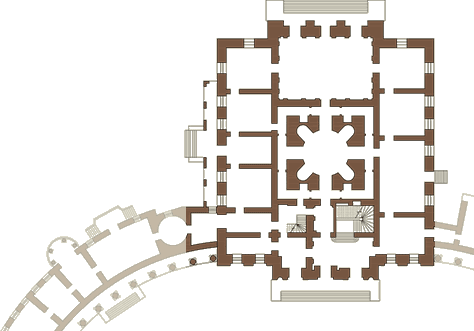The Billiards Room
Загрузка панорамы...
In 1784–1786, Charles Cameron decorated this square corner room in the northwestern part of the Palace. This room was not redecorated, so its main details survived to this day. (During the fire of 1944, this room suffered less than others: only the center of the plafond collapsed, so the stucco decor mostly survived). There are seven drawings and templates for the design of the Billiards Room from the Cameron period in the museum's architectural graphics holdings. The white color of the walls and ceiling without any gilding give the room a strict simplicity, while carefully thought-out elements of stucco decoration with their periodic symmetry contribute to the impression of classical completeness of the interior. The clearly expressed division of the walls into rectangular and square panels is emphasized by light stucco molding. Along the upper perimeter of the walls, there is a stucco frieze resembling Ancient Greek triglyph-and-metope frieze with alternating ornamental motifs. Then there is the stucco cornice of the ceiling with ionics and palmettes and, finally, the square field of the plafond: a light spherical vault with diverse stucco decor. The center is emphasized by an elegant stucco rosette in the form of stylized acanthus leaves. Echoing its outlines, a circle in the form of a wide ribbon of molded rosettes blends in the square of the ceiling. The artistic stucco was executed by the masters Antonio Bernasconi and Domenico Felice Lamoni. Sculptural bas-reliefs adorn the four resulting triangular spandrels: Hermes and Thetis, Hymenaeus with a Torch, Venus and Adonis, and two unknown female figures. The bas-reliefs were made by the sculptor Mikhail Aleksandrov-Uvazhny, who received the academician title in 1785. It was one of his first works in Pavlovsk.
On the walls, there are vedute of Italian artists of the Canaletto school with views of Venice, which Pavel Petrovich and Maria Fyodorovna visited during their trip in 1781–1782. Of particular note is The View of the Grand Canal by Bernardo Bellotto, the nephew of the famous Giovanni Antonio Canal (nicknamed Canaletto), and two paintings by Francesco Guardi: the View of the Grand Canal, Venice, with the Church of Santa Maria della Salute, and The View on the Grand Canal at San Geremia.
The interior decoration includes Russian furniture made at the end of the 18th century: a set of mahogany seating furniture with brass ornaments, very characteristic of the era of Emperor Paul I, as well as marquetry card-tables.
Opposite the window, is an unusual three-tiered mahogany console table with gilded bronze trim and brass molding (Russia, the early 19th century). The “facade” of the table is decorated with a blue porcelain plaque with a white multi-figure bas-relief Diana and Endymion (England, Josiah Wedgwood manufactory, the late 18th century). The production of such plaques of various shapes was one of the directions of the manufactory since furniture makers and bronze workers gladly used them to decorate their products. The platforms of each tier of the table are decorated with an openwork balustrade made of bronze. On the upper platform, there is a clock in a wooden case in the so-called “architectural” style, made in the workshop of the famous German furniture maker David Roentgen.
A special place in the museum's collection is occupied by a unique musical instrument located in the Billiard Room: the clavichord in a marquetry case, its keys decorated with mother-of-pearl and tortoiseshell. It was made in 1783, in the Saint Petersburg workshop of the famous piano master Johann Gottlieb Gabran. Prince Grigory Aleksandrovich Potemkin-Tauricheski ordered it as a gift to Empress Catherine II.
On the east wall, there is a marble fireplace; its shelf holds gilded and glazed white porcelain wares of the late 18th century: an incense burner vase of the Berlin porcelain manufactory (a gift from King Frederick II, who was Maria Feodorovna's great-uncle) and jug vases of the Ludwigsburg porcelain manufactory (presented by Duke Charles Eugene, Maria Feodorovna's uncle).
According to the inventory of 1790, there was also a mahogany billiard table covered with green cloth. The game of billiards came into fashion at the end of the 18th century. In 1858, the Billiards Room became the study of Grand Duke Konstantin Nikolaevich. The billiard table was moved to the Strelninsky Palace, where its traces were lost.
The Billiards Room on the floor plane
- The Raspberry Study
- The Common Study
- The New Study
- The Corner Drawing Room
- The White Dining Room
- The Billiards Room
- The Old Drawing Room
- The Ball Room
- The French Room
- The Dark Pantry

Back
